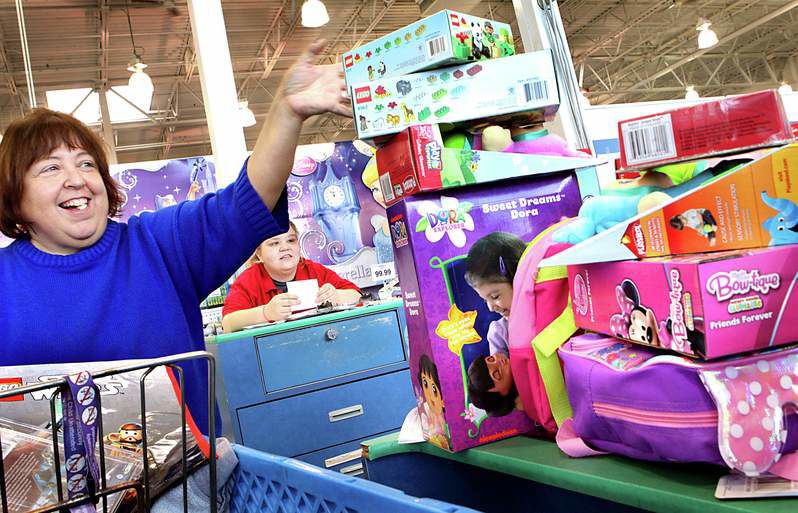Despite uncertainty, shoppers off to early start for holidays
Published 5:00 am Saturday, October 20, 2012

- Mary Miley of Valley Park puts Christmas gifts for grandchildren on layaway last week at Toys R Us in Sunset Hills, Mo. Miley, who pays them off in cash, has two layaways at the store. “I usually start in July,” said Miley, smiling as she shopped for four grandkids and three great-nieces and nephews. “I'm getting a late start.”
Don’t try to tell retailers it’s too early for holiday shopping.
Toys R Us stopped accepting reservations because of high demand last month for the Tabeo tablet and Wii U game console as part of its new hot-toy holiday reservations list, which allows consumers to reserve popular items for later in the season.
Wal-Mart told investors last week that the company has already lined up $400 million in early holiday layaway sales in its program that launched a month earlier than last year. That is more than half the amount that shoppers put on hold in layaway at Wal-Mart during all of last year’s holiday season. Top items so far include 50-inch televisions, Apple’s iPad tablet and trampolines.
But there are still a lot of question marks about this holiday shopping season, which is the most important time of the year for most retailers.
The most recent jobs report, which showed that unemployment dropped to 7.8 percent in September — the first time it has dipped below 8 percent in three years — has provided some good news heading into the holidays.
But lackluster economic growth — as well as the looming fiscal cliff with tax increases and deep spending cuts that could take effect early next year if Congress doesn’t reach a budget deal — is also weighing heavily on consumers, analysts say.
Still, the National Retail Federation is expecting a 4.1 percent increase in holiday sales this year — its most optimistic forecast since the recession. That is below the 5.6 percent increase in actual sales during last year’s holiday season.
“Overall, we would view this forecast as good news considering the variables and uncertainty that still exists in our economy and the things that are on consumers’ minds,” Matthew Shay, the president of the NRF, recently told reporters on a conference call.
Retailers’ seasonal hiring looks to be on par with if not slightly larger than last year. Wal-Mart said it will bring on about 50,000 holiday workers this year — up slightly from last year.
Kohl’s is boosting its holiday workforce by 10 percent to about 52,700 employees. And Macy’s is inching up its holiday hiring by 2.5 percent to about 80,000 seasonal workers.
In total, the NRF expects retailers will hire between 585,000 and 625,000 seasonal employees this year, which compares to 607,500 seasonal employees hired last year.
One sign that consumers are still feeling a lot of economic pressures is the big response to holiday layaway programs already this year. After a strong showing to layaway programs last year, a number of retailers have dropped or lowered their upfront fees and rolled out the programs earlier than last year.
In early September, Toys R Us announced it was dropping its $5 service fee on layaway orders placed through Oct. 31. Like Wal-Mart, it also started its holiday layaway program about a month earlier than last year.
“To date, the number of layaway orders initiated in our stores has increased significantly over last year, a testament to how the free layaway offer is resonating with consumers,” Katie Reczek, a Toys R Us spokeswoman, wrote in an email.
As for inventory levels, Shay said retailers seem to be taking a mixed approach. About a quarter to a third of stores have indicated they are boosting inventory while the same amount say they are lowering inventory, he said.
“I think that wide range reflects there is still uncertainty in the economy,” he said. “People are hedging their bets.”
It’s been yet another roller-coaster year for retailers, he noted. The year started off with strong sales, which then tapered off in the spring. There was a strong summer, but it has then slowed again, too.
Jack Kleinhenz, the NRF’s chief economist, said the economy remains in a state of high anxiety.
“And I don’t expect that anxiety to dissipate,” he said.
But at the same time, he said that consumers are in some ways in a stronger position than they were last year with slightly more income, more savings on hand, and higher home values in their portfolio.
“I think that certainly influences peoples’ willingness to spend because they feel a little bit perhaps richer,” he said of the influence of home values. “I never count the consumer out. The economy may be in a lower gear, but as we’ve experienced, the consumer is certainly resilient.”
James Russo, Nielsen’s vice president of global consumer insights, said his firm has seen this year the highest level of consumer confidence heading into the holiday season that it has seen in the past four years.
“That gives us some sense that they have a cautiously optimistic approach for the holidays,” he said. “So there is some reason for hope.”






